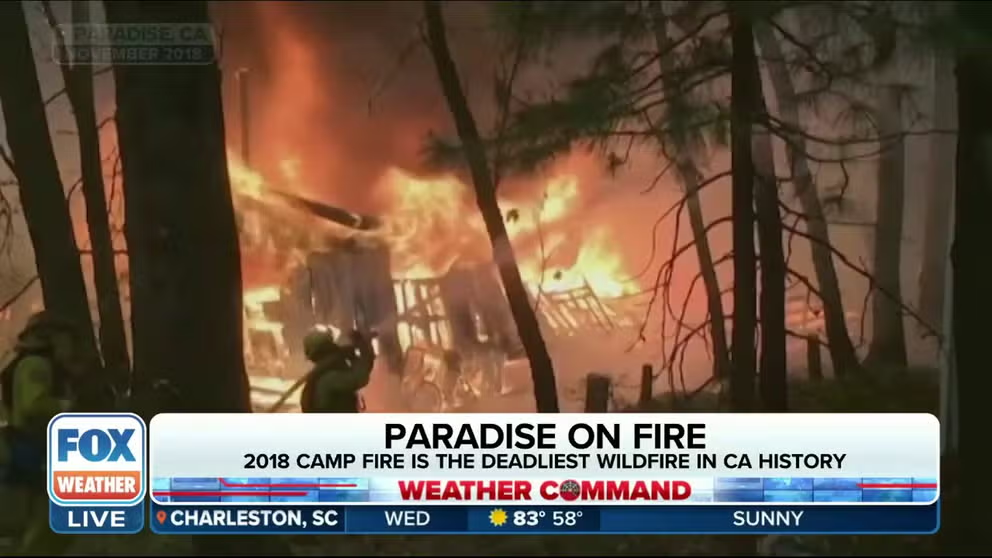US likely faces increasing wildfire risks as Americans build in fire-prone areas, study finds
"It is not a question of whether a wildfire will occur, but when," authors of a study published in the journal Science wrote.
Looking Back At Camp Fire: Five Years After Tragedy In Paradise, CA
It's been five years since the deadliest wildfire in California history. FOX Weather Correspondent Max Gorden takes a look back at the Camp Fire.
The number of homes in wildfire-prone areas has doubled since the 1990s due to housing growth and an increase in burned areas, leaving many more families vulnerable to wildfires, a study published in the journal Science on Thursday found.
More and more Americans are building homes in a wildland-urban interface (WUI), where homes and vegetation are in proximity. The 2010s saw 2.6 million additional homes being built in WUIs. The three decades before each saw an additional 5.7 million additional homes being built in these areas.
"We do not see slower development in the WUI despite the rapid increases in annual burned area of the last three decades," study author Volker Radeloff said. "Fire risk has risen, but development patterns have not changed."
Housing growth exposed about 47% of additional homes in the past 30 years to fire danger, while expanded burned areas added another 53% of homes. About 11.3% of homes within fire perimeters were destroyed by wildfire in that time.
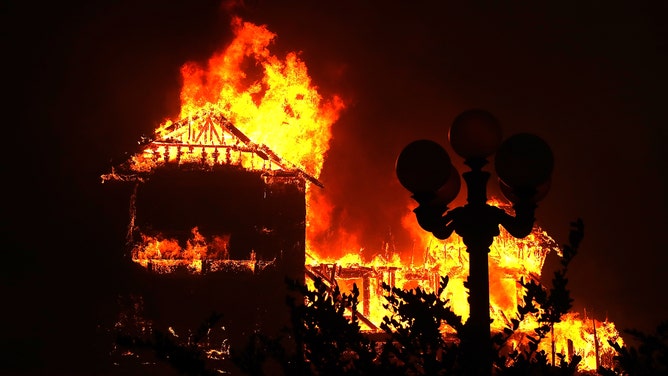
File: A home burns as the Camp Fire moves through the area on November 8, 2018 in Paradise, California.
(Justin Sullivan / Getty Images)
"Any WUI growth increases wildfire risk to houses, and more fires increase the risk to existing WUI houses," authors from the University of Wisconsin stated in the study. "During the 1990s and 2000s, the WUI was the fastest-growing land cover type in the U.S."
California and Texas have a large proportion of homes in WUI:
- Across the U.S., there are 44.1 million homes in a WUI.
- In California, there are 5.1 million homes in a WUI.
- In Texas, there are 3.2 million homes in a WUI.
"In Texas, housing growth in the total WUI was almost double the growth in non-WUI (20.3% versus 10.6%) during the 2010s, and 93.3% of all new houses in Texas during this most recent decade were built in WUI," the study read.
MULTIPLE WILDFIRES FUELED BY DROUGHT RAGE FROM TEXAS TO NORTH CAROLINA
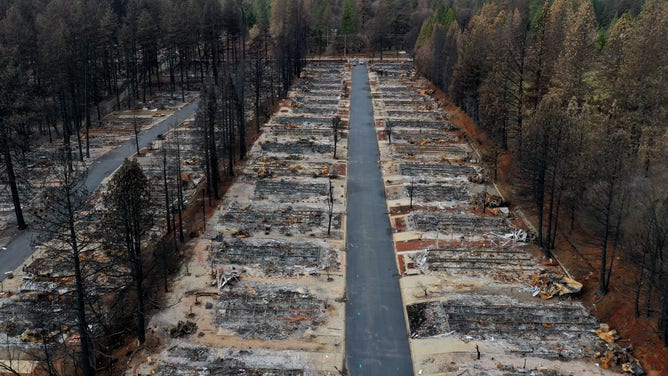
File: An aerial view of homes destroyed by the Camp Fire on February 11, 2019 in Paradise, California. Three months after the deadly and destructive Camp Fire, the community is beginning the rebuilding process.
(Justin Sullivan / Getty Images)
Between 2010 and 2022, more than 55,000 homes burned, leading to tragic loss of life, economic loss and disruption to whole communities as seen in Paradise, California. Only a third of homeowners have moved back after 95% of the once thriving town was destroyed in the Camp Fire, five years ago.
And that may be a positive thing, according to the study.
"Past wildfire areas had higher housing growth after wildfires than nonfire areas," reported the study. "These numbers suggest that wildfire occurrence is not discouraging development. Even if another fire is unlikely in the immediate aftermath of a wildfire because of a lack of fuel, past wildfire areas can burn again within years or decades, depending on the vegetation type."
WHY FIREFIGHTERS ARE FIGHTING WILDFIRES WITH FIRE
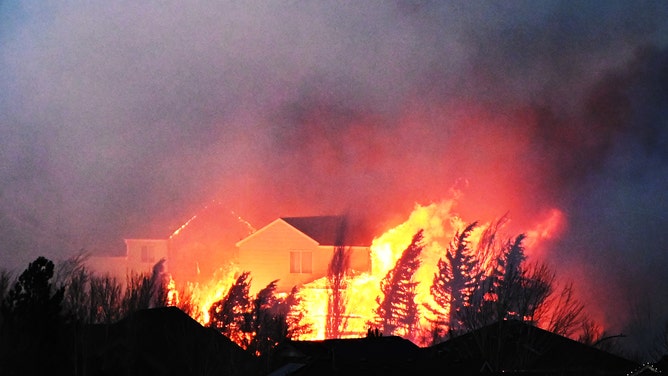
File: The Marshall Fire burning on December 30, 2021 in Broomfield, Colorado.
(RJ Sangosti/MediaNews Group/The Denver Post / Getty Images)
STATE FARM STOPS OFFERING HOME, PROPERTY INSURANCE IN CALIFORNIA AMID SKYROCKETING DISASTER RISKS
Over the past 50 years, the report said, housing growth far outpaced population growth in the U.S. with smaller household sizes and more second homes.
"Concomitantly, burned area has increased substantially as a result of fuel accumulation, human ignitions, and, in the West, earlier spring snowmelt and extended droughts," the study said.
Where you build matters
The type of vegetation surrounding your home matters. According to the study, the proportion of vegetation types within 0.6 miles of a home was a "significant predictor of loss."
Homes in evergreen and mixed forests were almost twice as likely to be destroyed in the event of a wildfire. Fires in the tops of trees in a forest are more intense and can disperse embers that ignite homes far from the fire front.
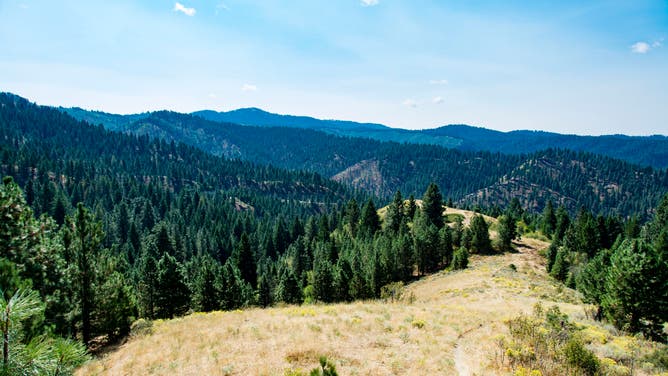
File: Scenic views of Boise National Forest in Idaho.
(Education Images / Universal Images Group / Getty Images)
The destruction rate of homes affected by shrubland fires was much lower than forest fires, but the total area burned by grass and scrubland fires is much larger. According to the study, 67% of areas burned in wildfires were in grass or scrublands. Only 33% of land burned by wildfires was in a forest.
"Houses surrounded by forests are most likely to be destroyed when a wildfire occurs, because forest fires are often very intense," Raadeloff said. "But the area that burns every year in grass and shrubland is much larger than that of forest fires. That is why grass- and shrubland fires destroy more houses."
"Fuels in a grassland can recover in just a few years after a fire to the point that that area can burn again," he continued.
Location also matters. According to the study, nearly 70% of homes destroyed in wildfires were in the West.
In the East, more than 80% of homes that were lost in a wildfire were in a forest. Conversely, 79.5% of buildings destroyed in a wildfire were in grass or scrublands.
"Our results highlight that homeowners and communities in the WUI have experienced wildfires more frequently in recent years," the authors wrote. "In many WUI areas, it is not a question of whether a wildfire will occur, but when."
LARGEST FIRE IN NEW MEXICO HISTORY CAUSED BY PLANNED BURNS, FEDERAL REVIEW FINDS
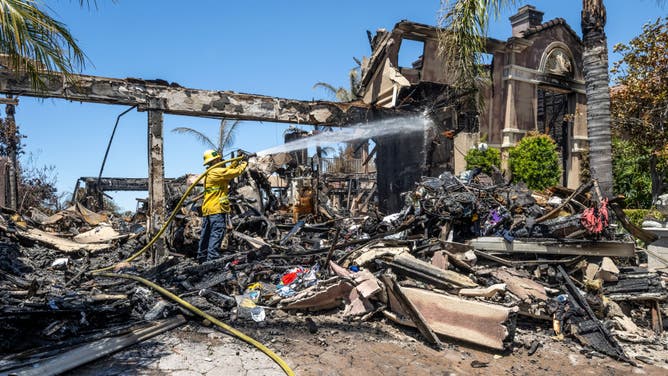
File: A firefighter puts out hot spots at a house on Coronado Pointe in Laguna Niguel, CA on Thursday, May 12, 2022.
(Paul Bersebach/MediaNews Group/Orange County Register / Getty Images)
SURVIVAL EXPERT OFFERS TIPS TO PROTECT YOUR HOME FROM WILDFIRES
Protecting property from wildfire
Authors said coordinated actions between homeowners, builders, communities and public agencies can limit the loss of homes and lives in the future.
Suggestions in the study include:
- Harden homes to fire.
- Limit ignitions, especially during high wind events, by improving the electric grids and using proactive electric shutdowns.
- During fires, authorities should predict the likely direction of the fire's path and immediately alert residents.
- Limit invasive, fire-prone species and prevent them from edging out native plants.
- Maintain defensible space around buildings.
- Cut more fire breaks to slow the spread of fires.
- Use tips in Firewise USA.
"It would be wise to limit future development in areas that are highly fire prone," Radeloff said. "However, there are already millions of homes in the WUI, and homeowners can do a lot to 'harden' their homes so that they may survive a fire if it occurs."
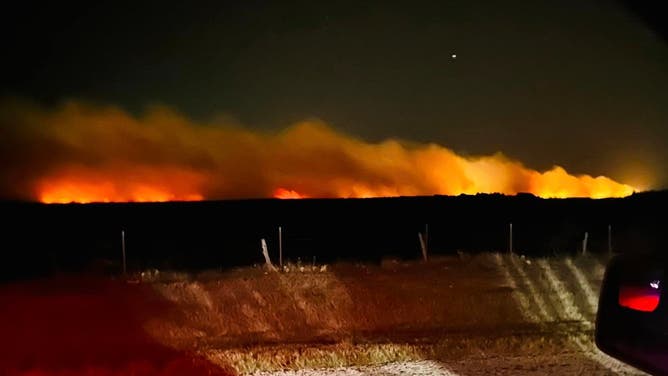
File: Wildfire burning in Archer County, Texas.
(Archer County Sheriff's Office / FOX Weather)
They also suggested legislative and forest maintenance efforts to reduce the number of homes threatened.
"If a policy goal is to limit risk to newly developed houses, this could be accomplished by both stricter building standards and land-use planning to avoid construction in the areas where fires are most likely to occur."
